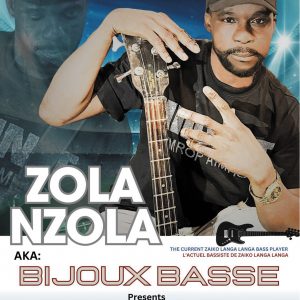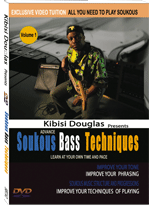THE ART OF SOUKOUS SOLO GUITAR
£15.50
Currently our DVDs do not contain any notation. African musical styles are predominantly an oral tradition and as such most musicians do not work from notation. Running time 80mins ,18 Exercises.
He began playing guitar atthe age of 14. Within a couple of years,Diblo’srumba skills caught the attention of “le maitre franco” himself, who offeredDiblo opportunitiesin his band, L’OrchestreOK Jazz, as well asin the studio where Diblo really excelled and quickly become a top sessionmusician,reportedly playing and composingmusic on oversixty albumsfor others artists. In the early eighties,Diblo decided tomake amove, as didmany of his compatriots,to amore lucrative city called Paris and joined forces with the singer Kanda,the leader of an impressive new soukous band. Together,Diblo and Kanda pioneered a new red hot soukous style that was virtually a stripped down version ofthe traditional Congolese rumba.Gone wasthe old style of 3 partstructure rumba songs.Diblo started with a bang directly to the soukous dance fire dominated by the guitarlicks called ”seben,” very danceable and captivating to the audience. Despite the overwhelming success oftheir collaboration,Diblo decided to break away fromKanda’s band and front his own group ofmusiciansin 1986 which he called Loketo. The band highlighted veteran singer and charismatic Aurlus Mabele, along with Jean Baron and Mav Cacharel,the two other singersin the band and created a new sound that appealed to a sophisticated, urban and youthful audience, withDiblo showcasing his dexterity on the guitar. At that moment Diblo got histrademark name “magic fingers” or the “fastest guitaristfromthe west” by aNew York Timesjournalist. With his popularity and also touring in allthe festivals and clubsinNorth America and Europe,Diblo was approached by the legendaryDominican singerJuan LuisGuerra who signedDiblo to do three songsin his albumcalled Fogararte and the albumbecame a big success with the song called “SenaDibala.” He was also approach by another legend,David Byrne who did a studio recording session with him. By 1990, Shanachie Records produced three albums withDiblo, paving the way for countless otherssoukous artists. In 1992, Aurlus Mabele andDibloDibala separated and wenttheir own ways. As Aurlus keptthe name Loketo,Diblo created a new band called Matchatcha. It was nomatch for Loketo but a yearlater with the song “Laissez Passez,”Diblo broke the record in Europe and Africa forthe bestsoukous albumand song of the year,selling over onemillion records.He played in allthe clubs from Paris to Kinshasa,New York, Montreal and Japan






There are no reviews yet.